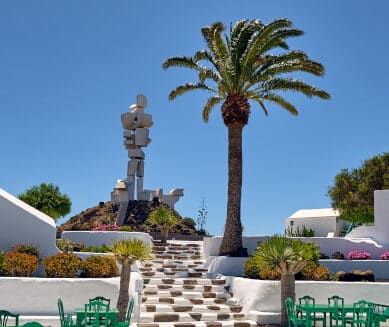Historical Routes in Lanzarote
The best historical routes in Lanzarote
If you want to discover Lanzarote’s most important historical places, take note of the following routes to avoid missing any details:
- North Route
Start the route in Teguise and head to the Casa de los Peraza, in Los Valles. Continue to the Corona Volcano to reach the Mirador del Rio, the Jameos del Agua and the famous Cueva de los Verdes. Continue the route to Arrieta and Punta Mujeres, two coastal towns. The Cactus Garden, also created by César Manrique, will be the last historical point to visit.
- South Route
Regardless of where you are staying, you should head towards the area of La Geria to get to know its beautiful and amazing lunar landscape. This region, known for its unique vine cultivation, will surprise you with a landscape full of holes dug in the volcanic ash as a form of cultivation. In addition, in the Bodegas El Grifo you can enjoy a guided tour of its Wine Museum. Afterwards, head to Uga and Yaiza. Continue along the road until you reach the Janubio Salt Flats to learn how sea salt was obtained years ago. Along the road, you will find the steep cliffs of Los Hervideros. If you follow the same road, you will reach the well-known Charco Verde or Charco de los Clicos, in the village of El Golfo. On the way back, you should head towards the Timanfaya National Park to get to know one of the island’s main tourist attractions.
- Downtown Route
In the capital you will find the Castillo de San Gabriel and the Castillo de San José. In Tahiche, a few kilometers away, you can visit César Manrique’s former residence, which is nowadays the headquarters of his foundation. The Villa de Teguise, the Castle of Santa Barbara and the Museum of Piracy are also mandatory stops. In Teguise, the Palacio de Spínola and the Casa Marqués de Herrera y Rojas. To end the tour you can go to the Monumento al Campesino, the Museo del Campesino and the Museo Agrícola el Patio.
The cheapest historic routes in Lanzarote
Lanzarote, declared a Biosphere Reserve by UNESCO in 1993, has different routes in which to discover in depth its history, culture and landscape. As for the costs, the island offers a wide variety of activities and tourist spots completely free of charge. In other historical sites you will need to buy a ticket to visit them. Among the routes mentioned above, the south route is probably the one that offers the largest number of free activities.
IT COULD BE USEFUL
Excursions in the best areas

